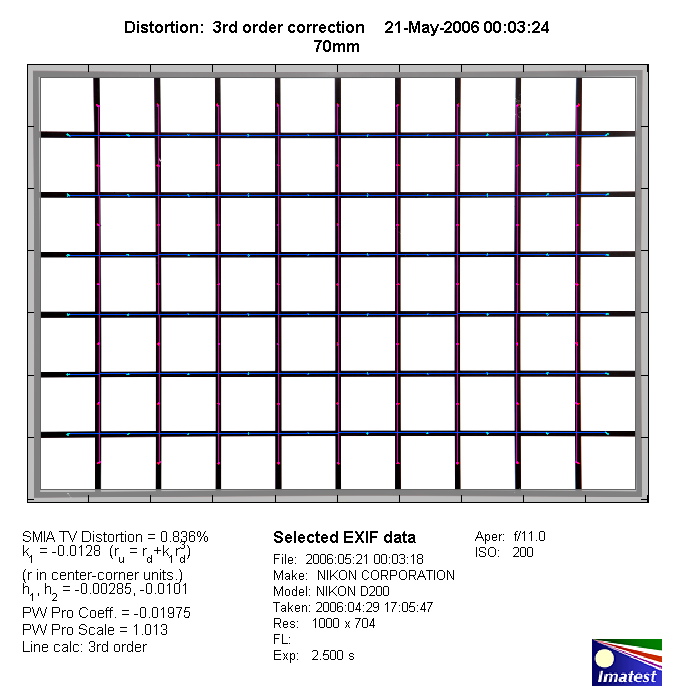|
Nikkor AF 24-120mm f/3.5-5.6D IF - Review / Lab Test Report - Analysis |
|
Lens Reviews -
Nikon / Nikkor (APS-C)
|
|
Page 2 of 2
Distortion
The AF 24-120mm has a rather aggressive 5x zoom ratio so distortion is a little
higher than average. Typical for such zooms there is some pronounced barrel
distortion at 24mm (2.1%) changing to moderate pincushion distortion (0.8%)
towards the long end of the zoom range. At 35mm the lens is free of distortion.
24mm:

35mm:

70mm:

120mm:

The chart above has a real-world size of about 120x80cm.
Vignetting
The AF 24-120mm VR is a full frame lens so on an APS-C DSLR it can take
advantage of a sweet spot effect and generally the issue is quite well
controlled. As to be expect the vignetting is most pronounced
at 24mm @ f/3.5. At around 1EV vignetting may be visible at times here but
the problem doesn't reach extreme degrees and if needed stopping down helps
to reduce the issue significantly. At the other tested focal lengths the
issue isn't really field relevant.

MTF (resolution)
In the MTF lab the lens was something of a mixed bag. The center resolution
is very good regardless of the focal length and across the tested aperture
range. At 24mm and 120mm the border resolution falls apart at wide-open
aperture. However, stopping down to f/5.6 already results in a quite harmonious
quality. At 35mm and 70mm the characteristic is less extreme. At wide-open
aperture the contrast performance seems to suffer specifically at the long
end of the zoom range.
The lens showed a focus shift when stopping down at the wide-end of
the zoom range (residual spherical aberration). The tested sample
may not have been the best representative of its species - there
was a visible centering defect at 120mm.
Please note that the MTF results are not directly comparable across the different systems!
Below is a simplified summary of the formal findings. The chart shows line widths per picture height (LW/PH) which can be taken as a measure for sharpness.
If you want to know more about the MTF50 figures you may check out the corresponding Imatest Explanations
Chromatic Aberrations (CAs)
Chromatic aberrations (color shadows at harsh contrast transitions) are
very low between 24-70mm. CAs increase somewhat at 120mm with an
average CA width beyond 1px at the image borders.

Verdict
The Nikkor AF 24-120mm f/3.5-5.6 D IF was an popular lens during
the film era but on APS-C DSLRs the focal length range isn't all
that attractive anymore. The performance of the lens is generally
good with a high center resolution throughout the focal length range.
Unfortunately the border quality is just so so at the extreme ends
at large aperture settings. Apparently the contrast level is somewhat
low at wide-open aperture so stopping down seems generally advisable.
The distortion and vignetting characteristic is about average for a lens
in this class. CAs are surprisingly low. Mechanically the lens feels
generally fine but the rotating front element leaves something to
be desired. The AF-S 24-120mm f/3.5-5.6G ED VR felt more convincing
during the local tests.
|